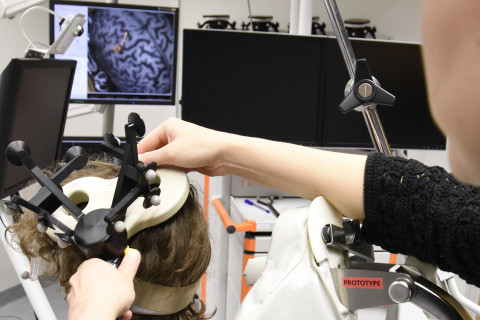In patients with progressive myoclonic epilepsy type 1 (EPM1), abnormality of intracortical inhibition measured by transcranial magnetic stimulation (TMS) is associated with the magnitude of the genetic change, a new study shows. According to the researchers, TMS could prove useful in assessing patient prognosis.
The study was undertaken at Kuopio University Hospital, the University of Eastern Finland, Chalfont Centre for Epilepsy in London and University College London, and the results were published in Epilepsia.
EPM1 (also known as Unverricht-Lundborg disease) is a rare, severe epilepsy. It is caused by changes in both copies of an individual’s CSTB gene. In most people with EPM1, the change in both copies is a repeat expansion (homozygous repeat expansion variant). The mechanisms by which loss of function of the CSTB protein leads to epilepsy and other manifestations of EPM1 remain incompletely understood. Previous research suggests that abnormal function of inhibitory networks of the surface of the brain, mediated by gamma-aminobutyric acid (GABA), may be involved.
Unfortunately, there are no disease-modifying treatments for EPM1. The condition is progressive, and most patients ultimately lose the ability to mobilise without walking aids and have difficulties with many activities of daily living. However, there is significant variability in the course of the disease from individual to individual. There is some evidence suggesting that among patients with EPM1, the longer expansion variant may be associated more severe disease.
Paired-pulse TMS is a non-invasive test for studying GABA-mediated inhibitory networks of the surface of the brain. Therefore, it might be a useful tool for gaining more insight into EPM1. Indeed, earlier studies have shown that people with EPM1 had impaired short-interval intracortical inhibition (SICI).
The present study examined the association between intracortical inhibition and clinical and genetic features in a group of individuals with EPM1. Nineteen people with EPM1 and seven healthy control participants completed the study. Compared to controls, patients demonstrated significantly less SICI. On group level, no difference was seen between patients and controls with respect to long interval intracortical inhibition (LICI). A combination of the two measures of intracortical inhibition was robust in discriminating patients and controls. In patients with EPM1 due to homozygote repeat expansions, the number of repeats in the more affected allele showed significant correlation with both measures of intracortical inhibition, with individuals with higher repeat number showing more impairment.
The results strengthen the finding of deranged GABAergic inhibition in EPM1. Intracortical inhibition as measured by transcranial magnetic stimulation may have use as a marker of GABAergic impairment in future treatment trials in EPM1.
For further information, please contact:
Katri Silvennoinen, Neurologist, MD
katri.silvennoinen(a)kuh.fi
Reetta Kälviäinen, Professor
reetta.kalviainen(a)uef.fi, tel. +358405839249
Kuopio Epilepsy Center
Kuopio University Hospital
Kuopio, Finland
Neurology, Faculty of Health Sciences
University of Eastern Finland
Department of Clinical and Experimental Epilepsy
UCL Queen Square Institute of Neurology
London, UK
Chalfont Centre for Epilepsy
Chalfont St Peter, UK
Publication:
Silvennoinen K, Säisänen L, Hyppönen J, Rissanen SM, Karjalainen PA, D'Ambrosio S, Jimenez-Jimenez D, Zagaglia S, Rothwell JC, Balestrini S, Sisodiya SM, Julkunen P, Mervaala E, Kälviäinen R. Short- and long-interval intracortical inhibition in EPM1 is related to genotype. Epilepsia. 2022, Nov 17. doi:10.1111/epi.17466
These research groups are members of the multidisciplinary Neuroscience Research Community (NEURO RC) at the University of Eastern Finland. NEURO RC aims to understand the disease-specific and common molecular mechanisms underlying neurodegenerative diseases and epilepsy and to identify novel biomarkers and therapeutic approaches for their prevention and cure. Comprising 17 research groups, NEURO RC integrates biological neurosciences with data sciences, neuro-innovations, and neuro-ethics. Learn more and connect with NEURO RC:
Website
Twitter



